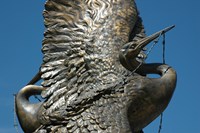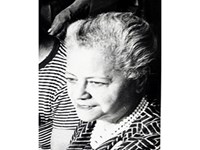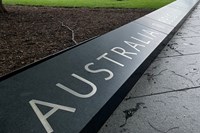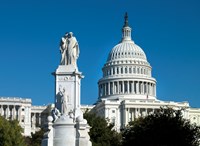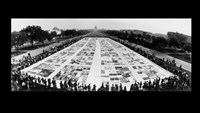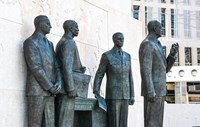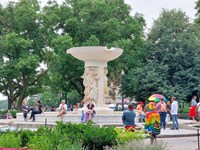- National Mall and Memorial Parks (566)
- Washington Monument (227)
- Belmont-Paul Women's Equality National Monument (59)
- Pennsylvania Avenue (35)
- Lincoln Memorial (30)
- The White House and President's Park (30)
- Rock Creek Park (28)
- Thomas Jefferson Memorial (23)
- Franklin Delano Roosevelt Memorial (21)
- Show More ...
- Harpers Ferry Center (13)
- Region 1: National Capital Region (9)
- Urban Ecology Research Learning Alliance (6)
- US Park Police (5)
- Interpretation, Education, and Volunteers Directorate (4)
- National Center for Preservation Technology and Training (4)
- Volunteers (4)
- Director (3)
- National Register of Historic Places Program (3)
- Show More ...
Showing 601 results for NAMA ...
Japanese American Memorial to Patriotism During World War II
Anna Arnold Hedgeman (1899-1990)
- Type: Place
The 44-foot high Peace Monument stands in the circle west of the U.S. Capitol at Pennsylvania Avenue and First Street, NW. Inscribed "In memory of the officers, seamen and marines of the United States Navy who fell in defense of the Union and liberty of their country, 1861-1865," this sculptural group has also been called the Naval Monument.
1979 Rally for the National March on Washington for Lesbian and Gay Rights
- Type: Place
At the end of the National March for Lesbian and Gay Rights, participants gathered near the base of the Washington Monument to listen to speakers proudly claim their queerness and paint a vision of a more inclusive future. One of these speakers was Charles Law, a Black gay activist based in Houston. He argued that the marchers must not fight for assimilate but integration so that all gay and lesbian people may one day enjoy the full benefits of their civil rights.
Franklin Park (Washington, DC)
- Type: Place
Congress set aside this five-acre park in 1832 to protect the fresh spring or springs on the site that were used to supply water to the White House several blocks to the southwest. Franklin Park supplied the water for all American presidents in the White House from Andrew Jackson through William McKinley. As an urban park, it is also a part of the fabric of the capital city, and a place for gathering, relaxing, and to see and be seen by various communities.
1987 AIDS Memorial Quilt on the National Mall
- Type: Place
The AIDS Memorial Quilt has travelled across the country and been displayed in many prominent places, including here on the National Mall in front of the Washington Monument. This was the ‘Inaugural Display’, the result of cumulative efforts of thousands of volunteers and countless hours of work. It is a tragic memorial to thousands of lives lost, while also representing the enduring love of those who knew them best.
- Type: Place
Dwight Eisenhower returned to Abilene on June 22, 1945 to a parade welcoming him home and honoring his leadership in Europe during World War II. After watching the celebration, his grateful acceptance of the recognition began with the above quote. He went on to say that this parade was not just for him; he was only a "symbol" of the soldiers, sailors and airmen who helped bring Allied victory.
- Type: Place
On the right side of the memorial core, Eisenhower as the Supreme Commander of the Allied Expeditionary Force during World War II is commemorated by a bronze heroic-sized statue with sculptures of his soldiers inspired by the famous photograph with the 101st Airborne Division before their jump into France. Behind the sculptures is a bas relief depicting the Normandy landings on D-Day, June 6, 1944.
- Type: Place
On the left side of the memorial core, the bronze heroic-sized statue of Eisenhower as 34th President of the United States places him at the center of the White House Oval Office flanked by sculptures of civilian and military advisors, symbolizing the balance Eisenhower struck between conflicting demands of national security and peaceful progress. The bas-relief global background depicts a map of the world symbolizing Eisenhower's role as a world statesman and preeminent inte
- Type: Place
“Kilroy was here”, accompanied by a cartoon drawing of a man looking over a wall, was a popular piece of graffiti drawn by American troops in the Atlantic Theater and then later in the Pacific Theater. It came to be a universal sign that American soldiers had come through an area and left their mark. There are two Kilroy inscriptions hidden in the memorial tucked in the corners of both the Atlantic and Pacific sides of the memorial. Can you find them?
- Type: Article
Every summer, the NPS Structural Fire Program recruits and places fire protection engineering, fire protection administration, and fire investigation students in NPS sites across the country to assist parks with meeting their structural fire management responsibilities. These interns bring their knowledge of fire protection systems and prevention strategies to the parks; in turn, parks offer vital work experience that the interns can take into future careers.
Commodore John Barry Memorial
Dupont Circle
- Type: Article
In this education activity for 7th-12th grade, students examine the inscription on the northeast interior wall of the Jefferson Memorial and compare it to the primary source documents from which it is quoted, the Virginia Statute for Religious Freedom and a letter from Jefferson to James Madison, written a decade later. Students explore how context affects their understanding of the text and are invited to write their own inscription using the same text.

